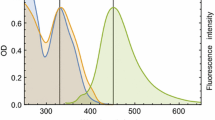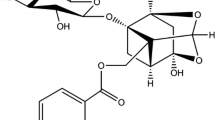Abstract
Binding of five perfluoroalkyl acids with human serum albumin (HSA) was investigated by site-specific fluorescence. Intrinsic fluorescence of tryptophan-214 in HSA was monitored upon addition of the chemicals. Although perfluorobutyl acid (PFBA) and perfluorobutane sulfonate (PFBS) did not cause fluorescence change, perfluorooctanoic acid (PFOA), perfluorooctane sulfonate (PFOS), and perfluorododecanoic acid (PFDoA) induced fluorescence quenching, from which binding constant of 2.7 × 105 M−1 for PFOA and 2.2 × 104 M−1 for PFOS was calculated. Two fluorescent probes, dansylamide (DA) and dansyl-l-proline (DP), were employed in fluorescence displacement measurements to study the interaction at two Sudlow’s binding sites. At Site I, both PFBA and PFBS displaced DA with binding constants of 1.0 × 106 M−1 and 2.2 × 106 M−1. At Site II, PFBS and PFDoA displaced DP with binding constants of 6.5 × 106 M−1 and 1.2 × 106 M−1, whereas PFBA did not bind. The data were compared with fatty acids to evaluate the potential toxicological effect of these environmental chemicals.





Similar content being viewed by others
References
3M Company (2000) Determination of serum half-lifes of several fluorochemicals, US Environmental Protection Agency Public Docket AR226-0645. 3M Company, St Paul
Andersen ME, Butenhoff JL et al (2007) Perfluoroalkyl acids and related chemistries—toxicokinetics and modes of action. Toxicol Sci 102:3–14
Ashbrook JD, Spector AA, Fletcher JE (1972) Medium chain fatty acid binding to human plasma albumin. J Biol Chem 247:7038–7042
Ashbrook JD, Spector AA, Santos EC, Fletcher JE (1975) Long chain fatty acid binding to human plasma albumin. J Biol Chem 250:2333–2338
Bhattacharya AA, Grune T, Curry S (2000) Crystallographic analysis reveals common modes of binding of medium and long-chain fatty acids to human serum albumin. J Mol Biol 303:721–732
Borges T, Glauert HP, Chen LC, Chow CK, Robertson LW (1990) Effect of the peroxisome proliferator perfluorodecanoic acid on growth and lipid metabolism in Sprague–Dawley rats fed three dietary levels of selenium. Arch Toxicol 64:26–30
Borges T, Robertson LW, Peterson RE, Glauert HP (1992) Dose-related effects of perfluorodecanoic acid on growth, feed intake and hepatic peroxisomal beta-oxidation. Arch Toxicol 66:18–22
Brown JR (1977) Serum albumin: amino acid sequence. In: Rosenoer VM, Oratz M, Rothschild MA (eds) Albumin structure, function and uses. Pergamon Press, Oxford
Butenhoff JL, Gaylor DW, Moore JA et al (2004) Characterization of risk for general population exposure to perfluorooctanoate. Regul Toxicol Pharmacol 39:363–380
Cheng YC, Prusoff WH (1973) Relationship between the inhibition constant (K_i) and the concentration of inhibitor which causes 50 per cent inhibition (I_(50)) of an enzymatic reaction. Biochem Pharmacol 22:3099–3108
Curry S, Mandelkow H, Brick P, Franks N (1998) Crystal structure of human serum albumin complexed with fatty acid reveals an asymmetric distribution of binding sites. Nat Struct Biol 5:827–835
Ghuman J, Zunszain PA, Petitpas I, Bhattacharya AA, Otagiri M, Curry S (2005) Structural basis of the drug-binding specificity of human serum albumin. J Mol Biol 353:38–52
Han X, Snow TA, Kemper RA, Jepson GW (2003) Binding of perfluorooctanoic acid to rat and human plasma proteins. Chem Res Toxicol 16:775–781
Hansen UK, Hellec F, de Foresta B, le Maire M, Møller JV (2001) Detergents as probes of hydrophobic binding cavities in serum albumin and other water-soluble proteins. Biophys J 80:2898–2911
Jisha VS, Arun KT, Hariharan M, Ramaiah D (2006) Site-selective binding and dual mode recognition of serum albumin by a squaraine dye. J Am Chem Soc 128:6024–6025
Jones PD, Hu W, de Coen W, Newsted JL, Giesy JP (2003) Binding of perfluorinated fatty acids to serum proteins. Environ Toxicol Chem 22:2639–2649
Kragh-Hansen U (1991) Octanoate binding to the indole- and benzodiazepine-binding region of human serum albumin. Biochem J 273:641–644
Kragh-Hansen U, Chuang VTG, Otagiri M (2002) Practical aspects of the ligand-binding and enzymatic properties of human serum albumin. Biol Pharm Bull 25:695–704
Lakowicz JR (1983) Principles of fluorescence spectroscopy. Plenum Press, New York
Lau C, Anitole K, Hodes C, Lai D, Pfahles-Hutchens A, Seed J (2007) Perfluoroalkyl acids: a review of monitoring and toxicological findings. Toxicol Sci 99:366–394
Lee IY, McMenamy RH (1980) Location of the medium chain fatty acid site on human serum albumin. Residues involved and relationship to the indole site. J Biol Chem 255:6121–6127
Lehmler HJ (2005) Synthesis of environmentally relevant fluorinated surfactants-a review. Chemosphere 58:1471–1496
Mahesha HG, Singh SA, Srinivasan N, Appu Rao AG (2006) A spectroscopic study of the interaction of isoflavones with human serum albumin. FEBS J 273:451–467
Nanda RK, Sarkar N, Banerjee R (2007) Probing the interaction of ellagic acid with human serum albumin: a fluorescence spectroscopic study. J Photochem Photobiol A Chem 192:152–158
Olsen GW, Burris JM, Burlew MM, Mandel JH (2003a) Epidemiologic assessment of worker serum perfluorooctanesulfonate (PFOS) and perfluorooctanoate (PFOA) concentrations and medical surveillance examinations. J Occup Environ Med 45:260–270
Olsen GW, Church TR, Miller JP et al (2003b) Perfluorooctanesulfonate and other fluorochemicals in the serum of American red cross adult blood donors. Environ Health Perspect 111:1892–1901
Ophaug RH, Singer L (1980) Metabolic handling of perfluorooctanoic acid in rats. Proc Soc Exp Biol Med 163:19–23
Organisation for Economic Co-operation and Development (OECD) (2002) Draft assessment of perfluorooctane sulfonate (PFOS) and its salt: complete assessment. Available via DIALOG. http://www.oecd.org/dataoecd/23/18/2382880.pdf. Cited 13 Oct 2005
Pandey RK, Constantine S et al (1997) Synthesis, photophysical properties, in vivo photosensitizing efficacy and human serum albumin binding properties of some novel bacteriochlorins. J Med Chem 40:2770–2779
Pardridge WM (1987) Plasma protein-mediated transport of steroid and thyroid hormones. Am J Physiol 252:157–164
Peter TJ (1995) All about albumin: biochemistry, genetics, and medical applications. Academic Press, New York
Peters TJ (1996) All about albumin: biochemistry, genetics, and medical applications. Academic Press, San Diego
Petitpas I, Grune T, Bhattacharya AA, Curry S (2001) Crystal structures of human serum albumin complexed with monounsaturated and polyunsaturated fatty acids. J Mol Biol 314:955–960
Rajaian H, Symonds HW, Bowmer CJ (1997) Drug binding sites on chicken albumin: a comparison to human albumin. J Vet Pharmacol Ther 20:421–426
Romanini D, Avalle G, Farruggia B (1998) Spectroscopy features of the binding of polyene antibiotics to human serum albumin. Chem Biol Interact 115:247–260
Roos PH, Angerer J, Dieter H, Wilhelm M, Wolfle D, Hengstler JG (2008) Perfluorinated compounds (PFC) hit the headlines. Arch Toxicol 82:57–59
Royer CA (2006) Probing protein folding and conformational transitions with fluorescence. Chem Rev 106:1769–1784
Scatchard G, Ann NY (1949) The attractions of proteins for small molecules and ions. Acad Sci 51:660–663
Simard JR, Zunszain PA, Hamilton JA (2006) Location of high and low affinity fatty acid binding sites on human serum albumin revealed by NMR drug-competition analysis. J Mol Biol 361:336–351
Sudlow G, Birkett DJ, Wade DN (1975) The characterization of two specific drug binding sites on human serum albumin. Mol Pharmacol 11:824–832
Sudlow G, Birkett DJ, Wade DN (1976) Further characterization of specific drug binding sites on human serum albumin. Mol Pharmacol 12:1052–1061
Tillement JR, Zini R, D’athis P, Vassent G (1974) Binding of certain acidic drugs to human albumin: theoretical and practical estimation of fundamental parameters. Eur J Clin Pharmacol 7:307–313
Zia H, Price JC (1976) Binding study of tetracyclines to human serum albumin using difference spectrophotometry. J Pharm Sci 65:226–230
Acknowledgments
This work was supported by the Chinese Academy of Sciences (KZCX2-YW-420-1) and the National Natural Science Foundation of China (20621703).
Author information
Authors and Affiliations
Corresponding author
Electronic supplementary material
Below is the link to the electronic supplementary material.
Rights and permissions
About this article
Cite this article
Chen, YM., Guo, LH. Fluorescence study on site-specific binding of perfluoroalkyl acids to human serum albumin. Arch Toxicol 83, 255–261 (2009). https://doi.org/10.1007/s00204-008-0359-x
Received:
Accepted:
Published:
Issue Date:
DOI: https://doi.org/10.1007/s00204-008-0359-x




